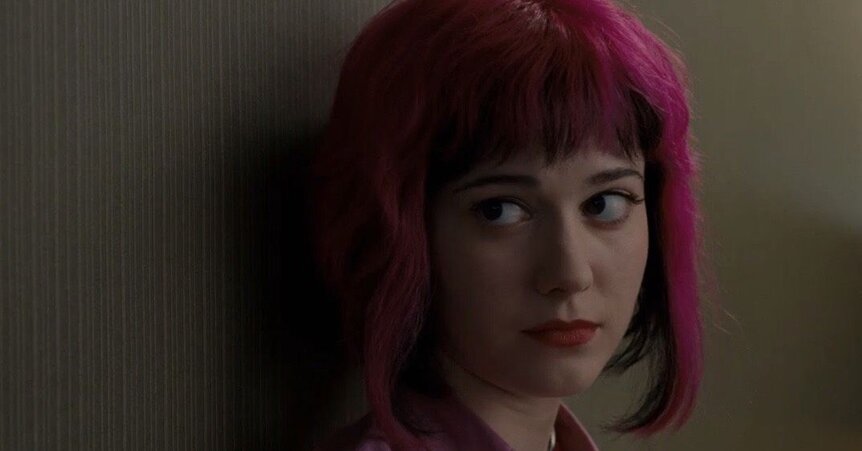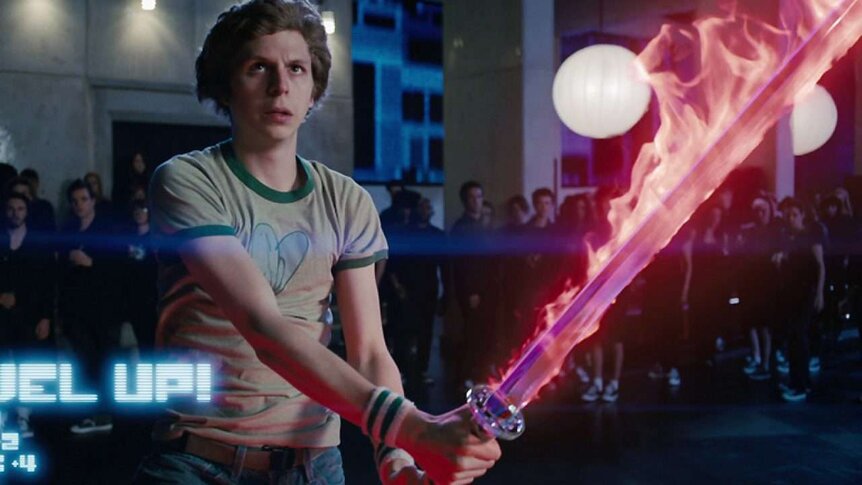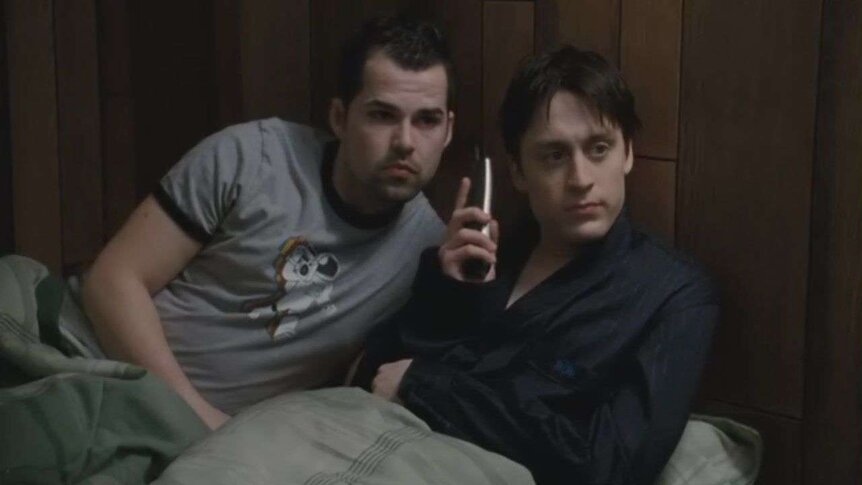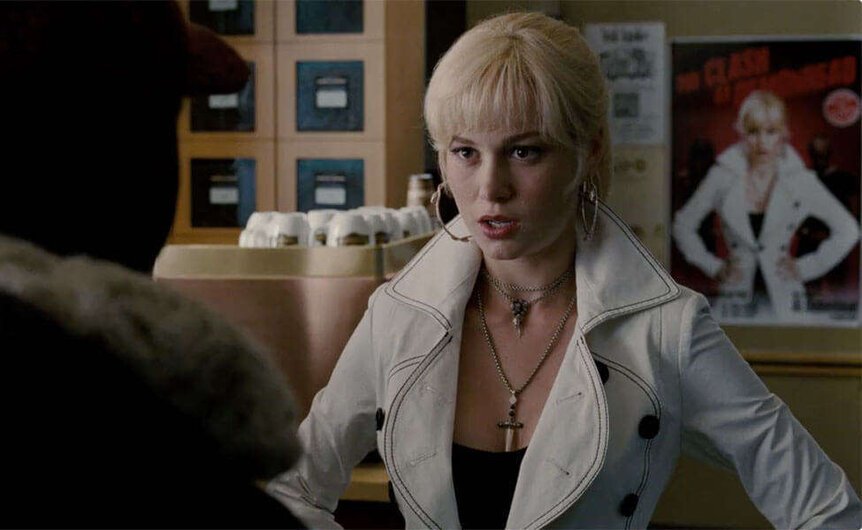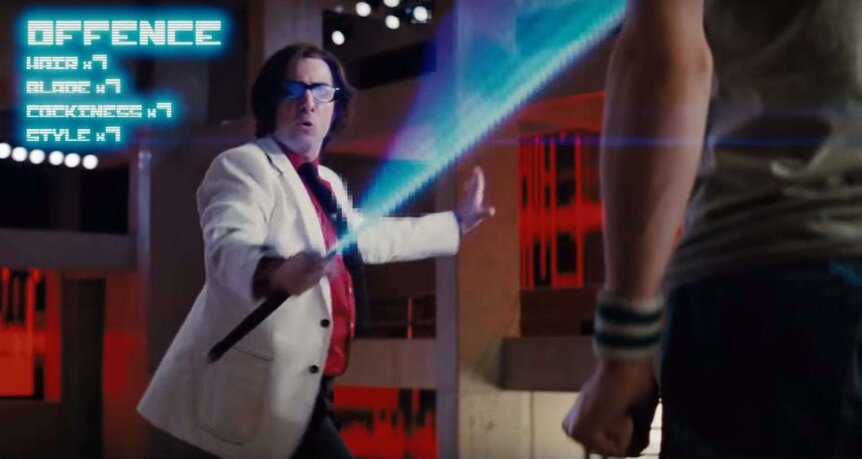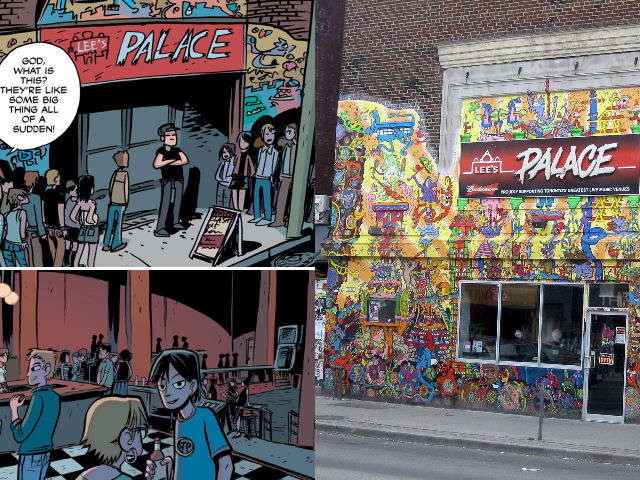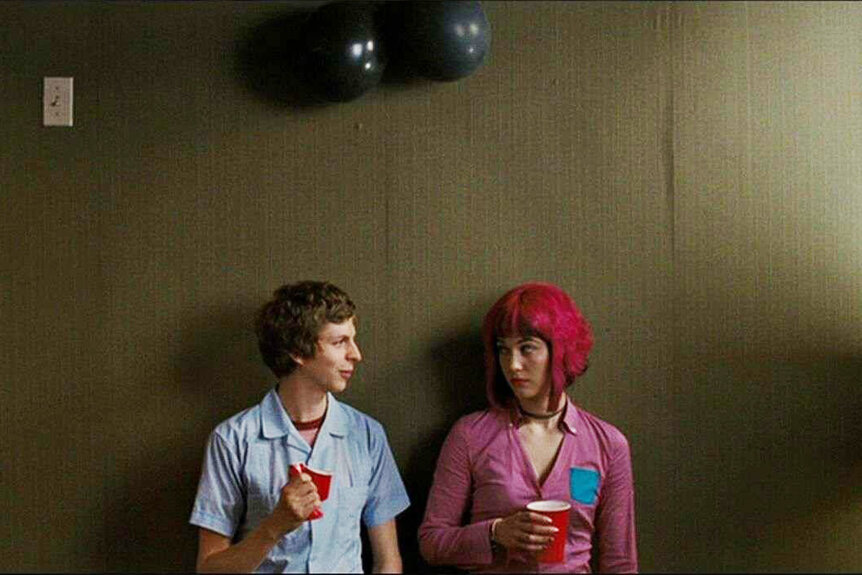Create a free profile to get unlimited access to exclusive videos, sweepstakes, and more!
Breaking down the tropes in Scott Pilgrim vs. the World
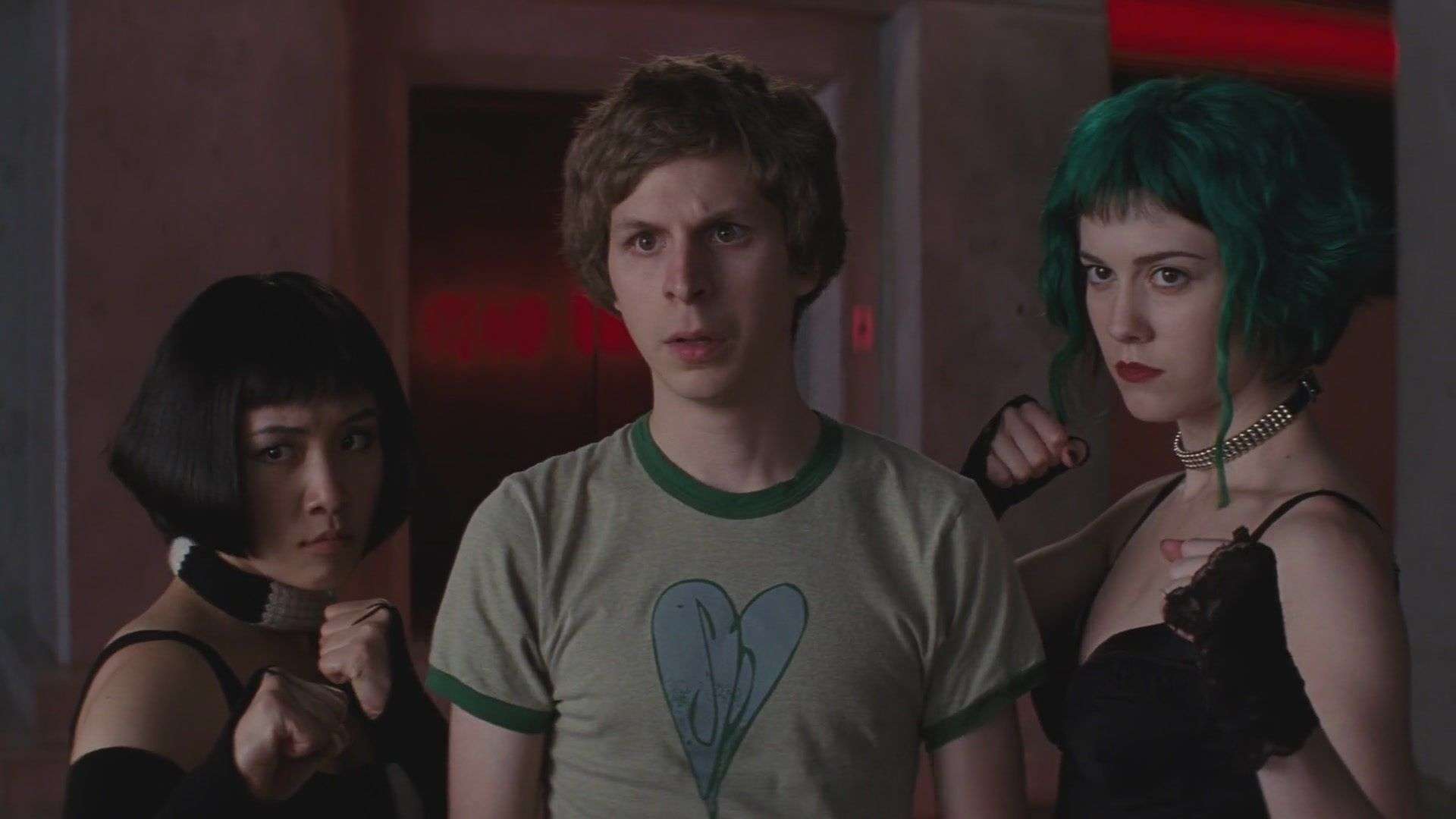
Scott Pilgrim vs. the World is perhaps known for being one of the most trope-filled popular films. Amidst running gags, an assortment of video game and pop culture references, and extreme stylistic choices unique to the movie, Scott Pilgrim contains many character and narrative-based tropes that make the film what it is.
Although there are hundreds of tropes in the film, SYFY FANGRRLS will be going through some of the film’s biggest tropes, analyzing and breaking them down, and deciding if the film subverts them, conforms to them, or does something else entirely.
Manic Pixie Dream Girl
This is one of the most well-known cinematic character tropes — but also one that is frequently contested in Scott Pilgrim. You’ll find many people arguing that Ramona Flowers is one of the most famous examples of a Manic Pixie Dream Girl, but you’ll probably also find people fighting against this.
Typically, a Manic Pixie Dream Girl is a female character who comes into the life of our straight-laced, boring male protagonist and gives him a whole new perspective, fueled by her quirky eccentricity, playfulness, casual attractiveness (but of course, she doesn’t know it!), and excitement for adventure. But usually, the Manic Pixie Dream Girl is defined only in terms relative to the man, and this aspect of her personality is all that’s there — which is what leads many to raise an eyebrow or two.
As for Ramona Flowers… most of our view of her is through Scott’s eyes. Scott is immediately infatuated and begins pursuing her, and Ramona gives him a chance. Even if she isn’t blatantly jumping into multitudes of wacky adventures, let’s be real — she is decidedly more exciting (and cooler) than Scott and as a consequence of dating her, has him rocketing into battles fighting her Evil Exes. She does have vague interests, but are they explored (beyond dying her hair a different color every week)? Not so much.
Our verdict: Sorry, but Ramona conforms to the Manic Pixie Dream Girl trope.
Crouching Moron, Hidden Badass
This is a trope that describes a character who seems wimpy, maybe a bit quiet… but suddenly, something happens — BAM! They’re so cool — maybe an expert martial artist? Or someone with genius-level intellect! They’re smooth, savvy, and slick all at the same time.
In the graphic novels, Scott is considered the “Best Fighter in the Province,” which makes the film’s decision to not include this seem quite purposeful. Above all, it’s just another element that contributes to the film’s larger-than-life, video game-esque quality. We’re not expecting Scott to have all these abilities, but somehow, he does.
Our verdict: Conforms to the trope, but happily so. We’re cool with it.
Asian characters
We’ve grouped these together because there’s a couple of tropes that both play into Hollywood’s depiction of characters of Asian descent more broadly.
First, the Genki Girl (“genki” is a Japanese word used in a multitude of contexts and is not directly translatable, but it’s typically is associated with energy and spirit). As such, the trope of the Genki Girl is that she’s super-excited! All of the time! She speaks fast! Or maybe she walks quickly and jumps up and down when she’s happy! (It also can be seen as a version of the Manic Pixie Dream Girl. Do with this info what you’d like.) And she’s often depicted as someone in school. Oh, Knives Chau. We love ya, Knives, but you fit this so well.
Second, the silent Asian characters. The Katayanagi Twins are depicted in only one scene, and they use music to battle Scott. We’re not even sure if we know which is Kyle and which is Ken — they’re just exes number five and six, and they don’t speak at all. The number of characters of color in this film are already limited, and these (arguably extremely badass) characters are relegated to a mere scene. What’s with that?
Scott Pilgrim does avoid other harmful tropes about Asian characters and people — like knowing kung fu, being nerdy and awkward, the “dragon lady” villain stereotype, among many — but the fact that the film averts certain tropes only to lean heavily into others is a little weird. (Actually, Wong’s taekwondo background helped her land the role of Knives, which is very cool. But because everyone in the film seems to magically break into some form of martial arts, Knives’ skills don’t fall as strictly into simply knowing martial arts because she’s Asian.)
Ellen Wong does an amazing job depicting the giddiness and sheer joy of Knives, but that’s owing to her and not the writing of the character itself. In the comics, the Katayanagi twins are described as a grandson jerk (Kyle, arms crossed smugly) and a perfect asshat (Ken, who’s drinking red wine), as adoring women look on.
Also, Matthew Patel's evil ex battle has a Bollywood sequence. Whew! If that's not blatant exoticization just for the sake of having a "fun" bit, we're not sure what is. No comment.
Our verdict: Ehh. Scott Pilgrim could’ve done better by our Asian actors and their characters. Sorry, folks.
Queer characters
We’ve gotten to part two of the “tropes involving characters who are either not white or not heterosexual.” There’s so many tropes here that we had to group them together again — mostly so we could show how overused and overdone these tropes are.
The All Gays Are Promiscuous trope! This can get dangerous, as it’s also gone beyond a cinematic/narrative trope and been claimed as a harmful stereotype. But in the case of Wallace, it’s played up so much that Wallace is decidedly cooler than Scott — and all of his partners seem okay with his polyamorous nature. Nobody’s complaining there! Even the gag of Wallace “stealing” all of Stacey’s boyfriends is depicted as more good-natured than anything else — Stacey and Wallace have a fun friendship (“Wallace, duh!”). And Scott sleeping in Wallace’s bed (along with a variety of Wallace’s partners) is never depicted as anything but the fact that Scott is, well, a struggling artist and they’re friends. We love empowering platonic relationships between men.
Roxy, on the other hand, very blatantly perpetuates harmful tropes about queer characters. The first trope that Roxy exemplifies is what’s often called the Psycho Lesbian trope, which is relatively self-explanatory and naturally incriminates the LGBTQ+ character as being innately dangerous and villainous. Ramona brushes Roxy off as being bi-curious and just having “a phase,” while Roxy hits back with “Well, honey, I’m a little bi-furious!” Alternatively, she also could be considered as exemplifying the same class of trope, except in the form of Depraved Bisexual (Roxy is never given the opportunity to explicitly define her own sexuality) — which is just as harmful.
Our verdict: We’re chill with Wallace. Roxy… not so much. Do better next time.
Femme Fatale
The Femme Fatale trope is often found in noir and detective stories, typically depicted as a seductress of some sort — she oozes sensuality and is there to cause trouble. But the men, naturally, can’t help but fall in love — they might even realize they’re falling prey to the Femme Fatale’s wiles.
Envy’s signature outfit in the film is the black dress, red lipstick, and black tights, but with a large white trench coat over it — an homage to and a subversion of the femme fatale wardrobe that’s often just a tight black dress. When she’s first presented in the film in images and as described, Envy conforms more to the Evil Diva trope — she’s a rock star not to be messed with, and she broke Scott’s heart. During the phone call with Scott, we only see her lips and she whispers into the phone.
When she gets on stage, she slinks around onstage as she sings — it’s clear that she’s très chic. But then after the concert, when she starts talking, you can’t help but start laughing. Her entire persona, demeanor, and voice are not what you’d expect of a femme fatale. Everyone is so scared of her (Stacey even calls her “She Who Must Not Be Named”), but suddenly, you realize that her sass is more like a stuck-up adolescent than anything else.
Most of the villains in Scott Pilgrim are extremely over-the-top and performative in nature, Envy Adams included. But Brie Larson’s portrayal of Envy is especially absurd, which is very fun.
Our verdict: Subverted! Envy Adams is hot and mysterious, but she’s also very extra in the least femme fatale-ish way possible. But in the best way possible.
Boss Battles
Each of the Evil Exes very clearly conforms to a Boss trope: the Warm-Up Boss (Matthew Patel), the Wake-Up Call Boss (Lucas Lee), Puzzle Boss (Todd Ingram), Breather Boss (Roxy Richter), Dual Boss (the Katayanagi twins), and the Final Boss (Gideon Graves)
With each battle, the Bosses grow harder and Scott faces different challenges. Starting with Matthew, Scott realizes what he's facing and is given a sort of trial run — with Lucas, he realizes that it’s started to get real. He defeats Todd through trickery and Roxy is that wild-card boss who isn’t that hard to defeat but has a weak point that Scott must exploit. And, of course, Scott defeats both Kyle and Ken at once and Gideon must be defeated twice as the final boss.
Our verdict: Conforms to the trope — but on purpose. It’s kind of cool, actually!
Self-referencing
Scott Pilgrim does a lot of meta-level referencing, but perhaps the clearest example is the way in which the film jokes and immediately points out how it’s set in "the faraway land of Toronto, Canada." The film isn't particularly Canadian in a stereotypical kind of way, but it does reference Pizza Pizza (a big chain in Ontario), has an event at Lee's Palace (an actual venue in Toronto), and the coins of defeated exes come out in coins in dominations of one and two Canadian dollars.
There’s a moment when acute viewers can overhear the phrase “The comic book was better than the movie,” a sly bit of self-deprecation and self-aware referencing. Scott even asks, “They make movies in Toronto?” in reference to Lucas Lee’s film. There’s even a fun Easter Egg — the fictional movie set contains a backdrop of the Empire State Building, and when Scott is flung through it, the CN Tower is visible in the background.
Our verdict: Not particularly strong, but conforms to the trope of being overly self-referential to avoid criticism. Also known as "lampshading."
Genre and style variations
There’s a bizarre scene in the film that mimics the humor and narrative style of Seinfeld (complete with laugh track), which feels out of place but not so much in the chaotic realm of Scott Pilgrim’s genre-defying style. The sitcom format isn’t so much of a trope as it is a style, but because of Seinfeld’s notoriety, Scott Pilgrim can be seen as playing on a genre trope.
The film also changes between an aspect ratio of 1.85:1 and 2:39:1 — the latter of which is ever so slightly wider than the former (which is confusingly known as widescreen). Typically, these changes are done to emphasize an element in the scene, as it crops vertically and makes the image look wider and more horizontal. Aspect ratios are a tool used by filmmakers developing a certain style for their works, but discrete changes are also a signaling tool to change the mood or even play to the conventions of certain aspect ratios (wider images are often seen as “more cinematic,” a stereotype that can be subverted).
Our verdict: A fun but bizarre inclusion. Conforms to the trope.
Chekhov's Gun
The narrative trope or device popularized by writer Anton Chekhov in which he suggested that everything included in a story needs to be included intentionally and must be essential. However, this is typically taken as something of a “plant-and-payoff” — that is, something earlier in the film (often unnoticed) comes back to play an important role later.
In Scott Pilgrim, Scott gains an extra life when he defeats the Katayanagi twins. This later comes in handy when he dies at the hands of Gideon and gets an extra change to defeat him. Similarly, Scott and Knives playing Ninja Ninja Revolution together becomes useful when the band together to defeat Gideon.
Our verdict: The extra life is pretty sneaky! It seems like another non-consequential video game element until it's not. Similarly, Scott and Knives playing the game together is kind of cute. Conforms, but in a fun way.
Bonus Round!
This is our own bonus round! (Not an actual trope of a "bonus round," sorry.)
Outtakes, bloopers, and gag reels are frequently included in bonus material, making them a semi-trope. As seen in the Scott Pilgrim outtakes, apparently it took Michael Cera 33 takes to throw the delivery box into the garbage can. Incredible.
